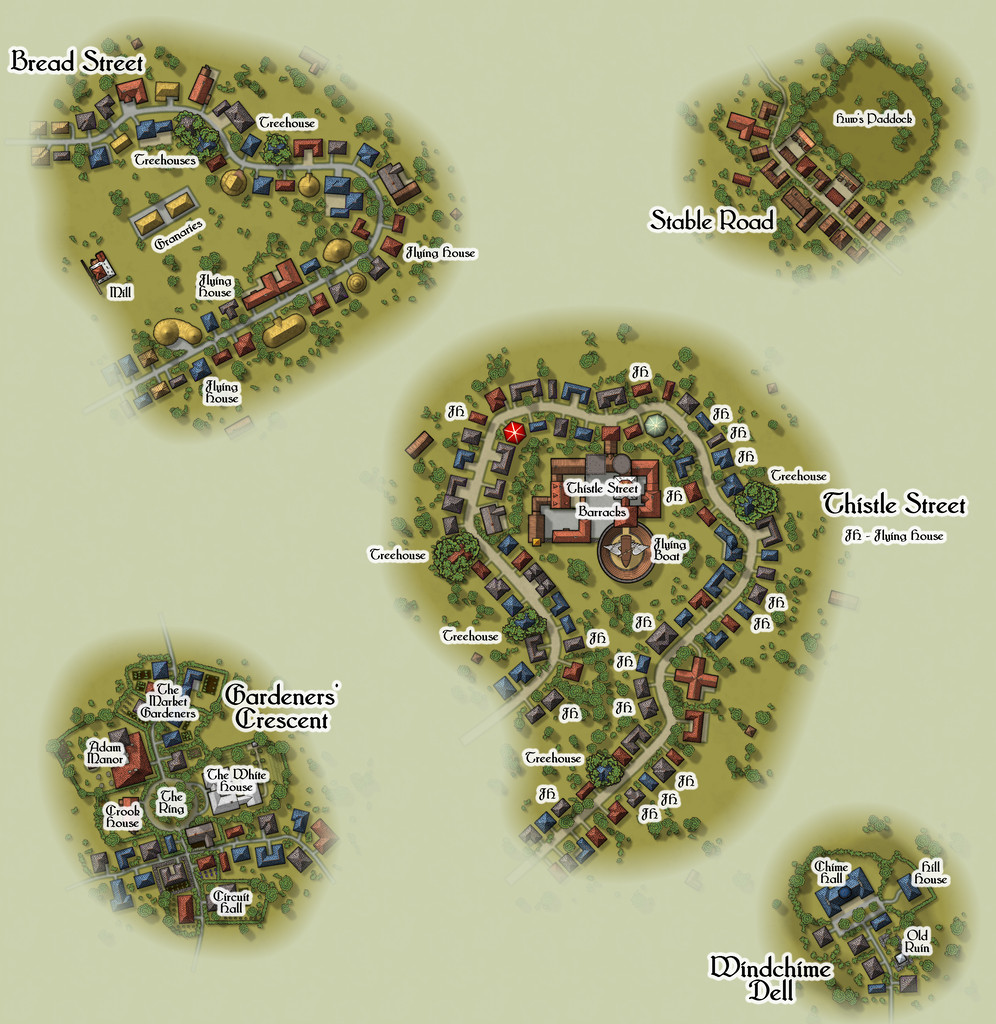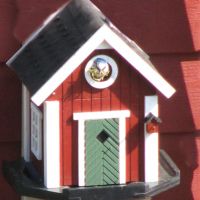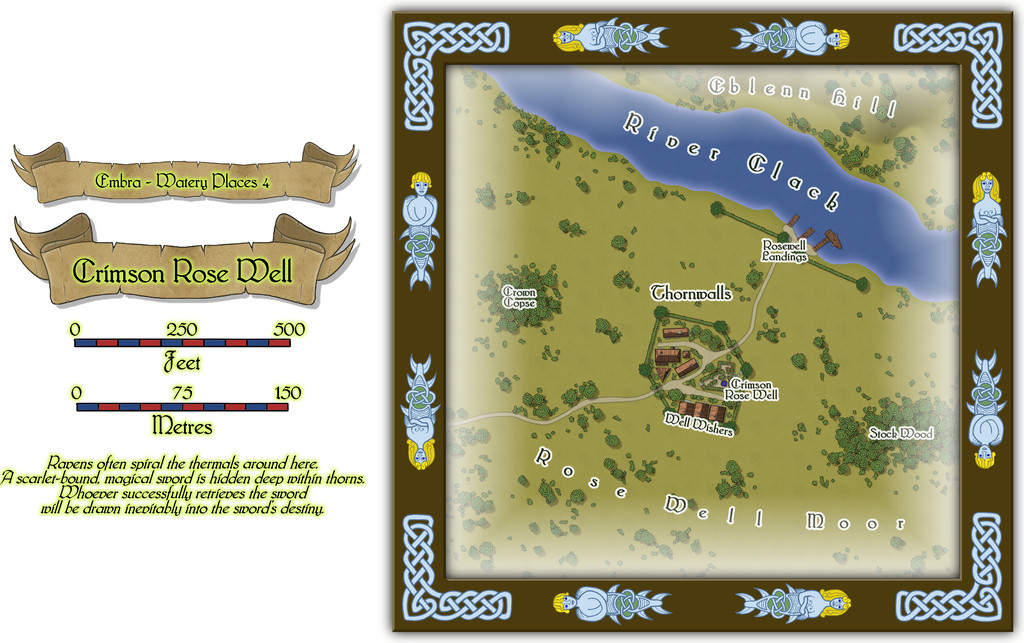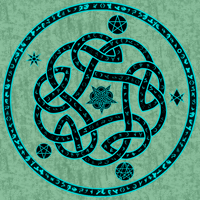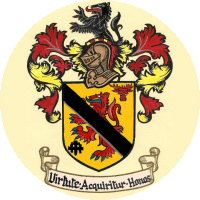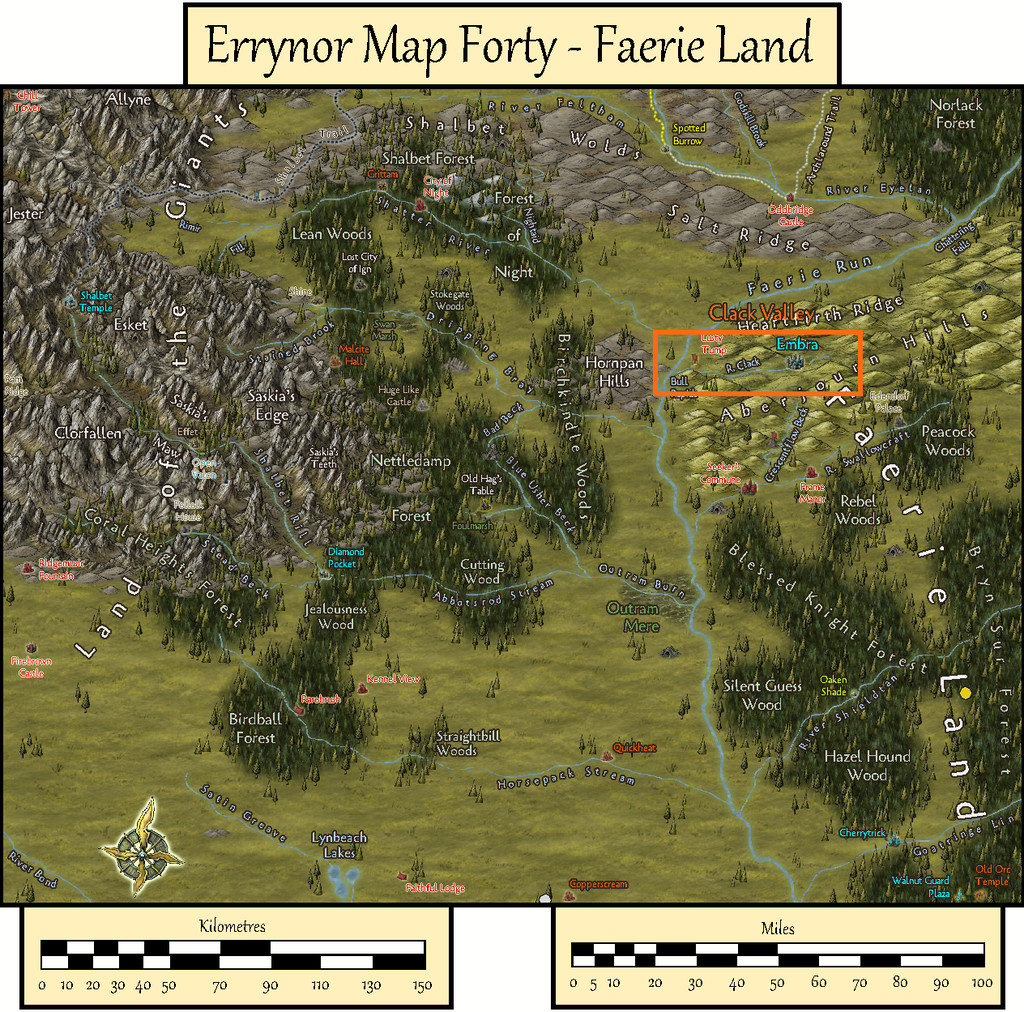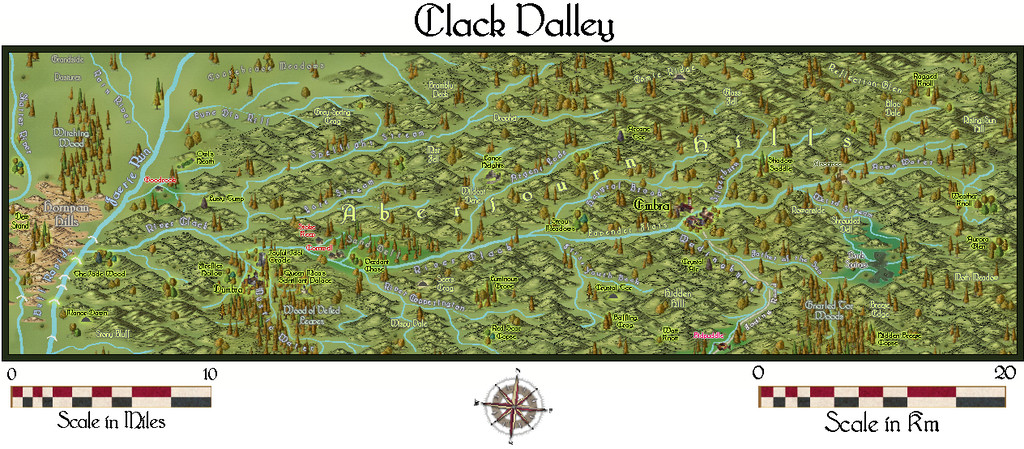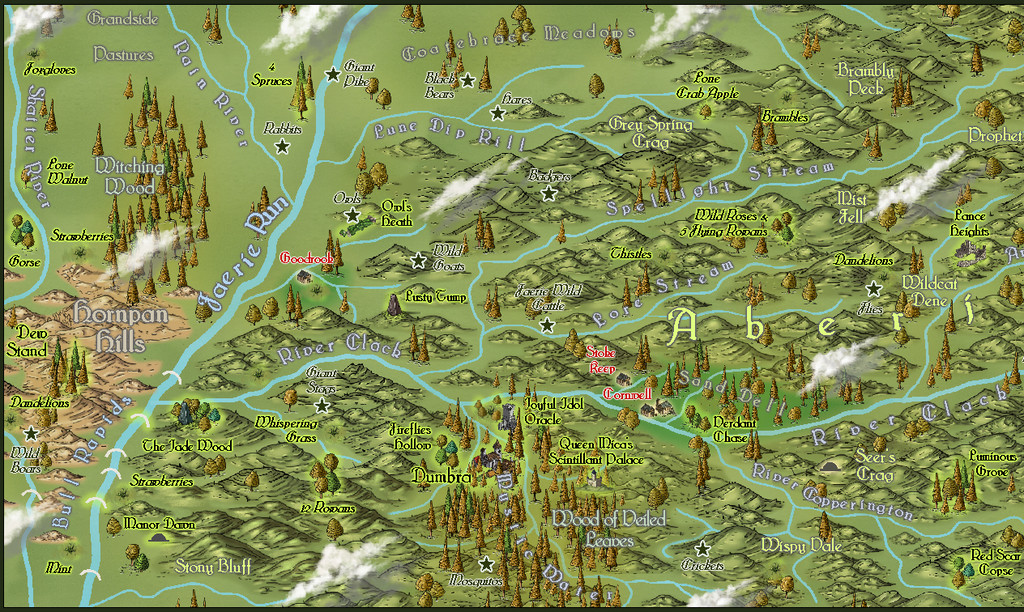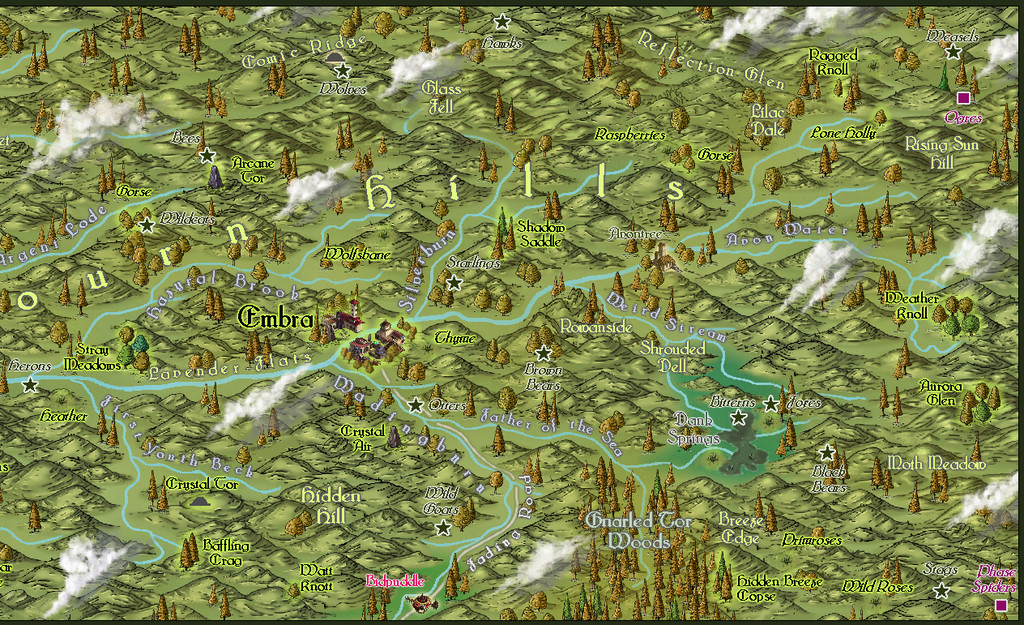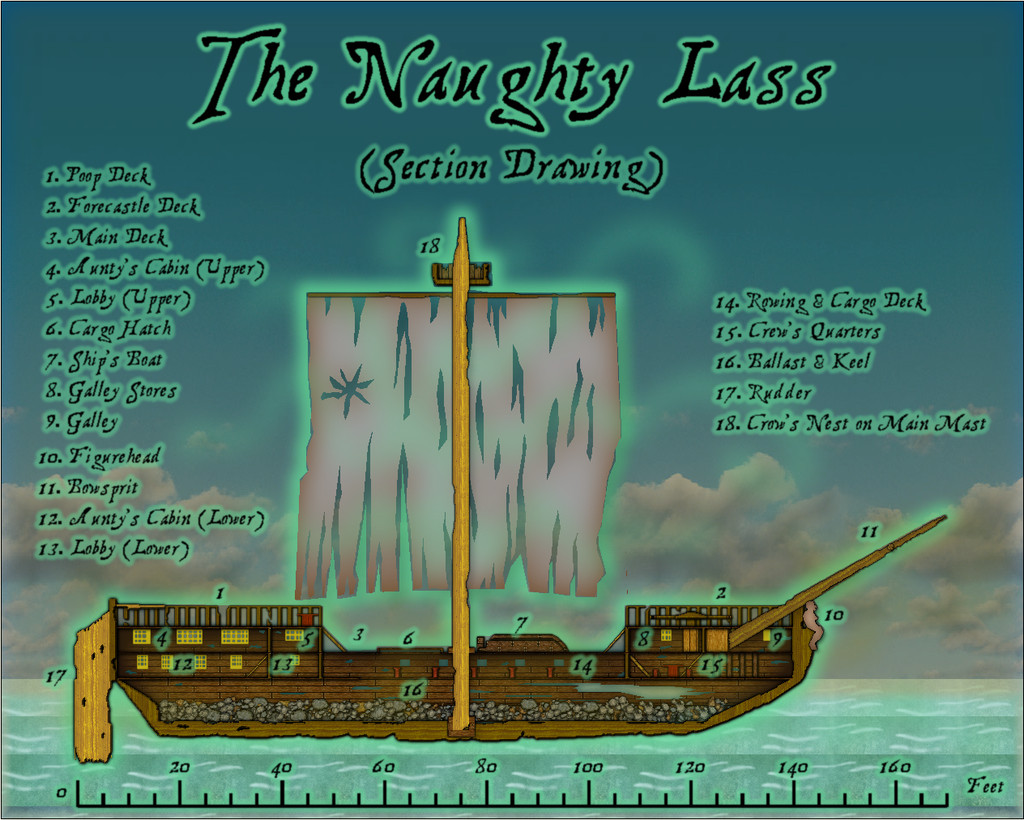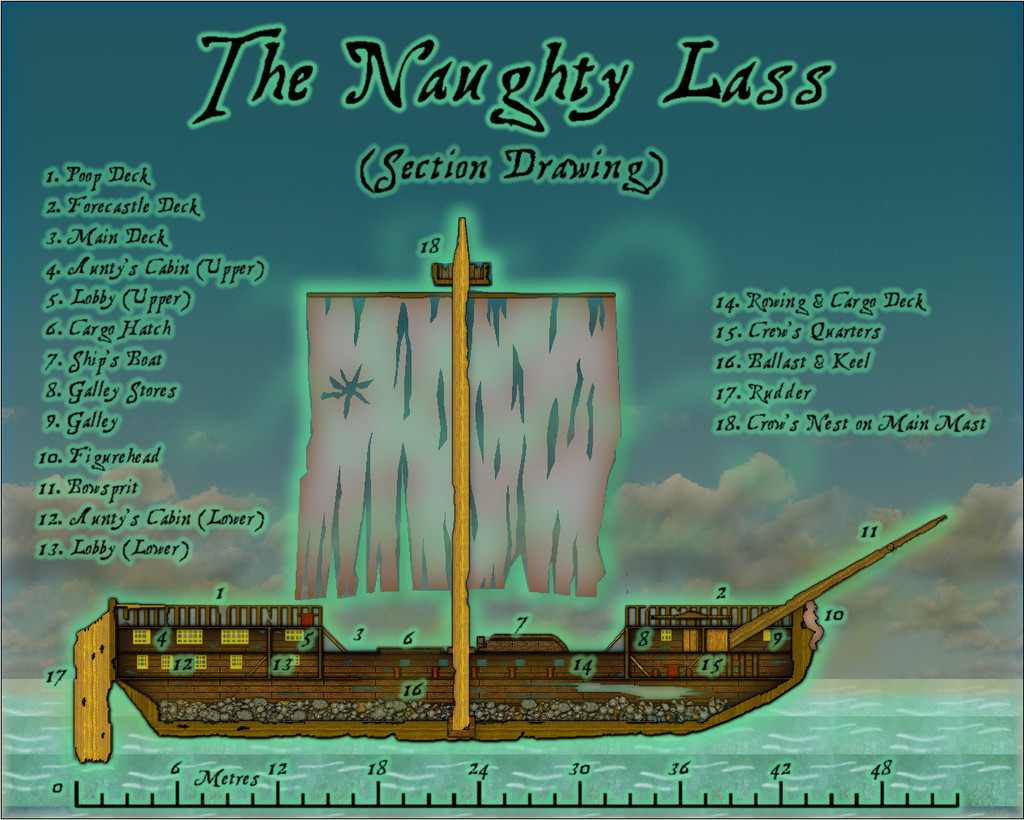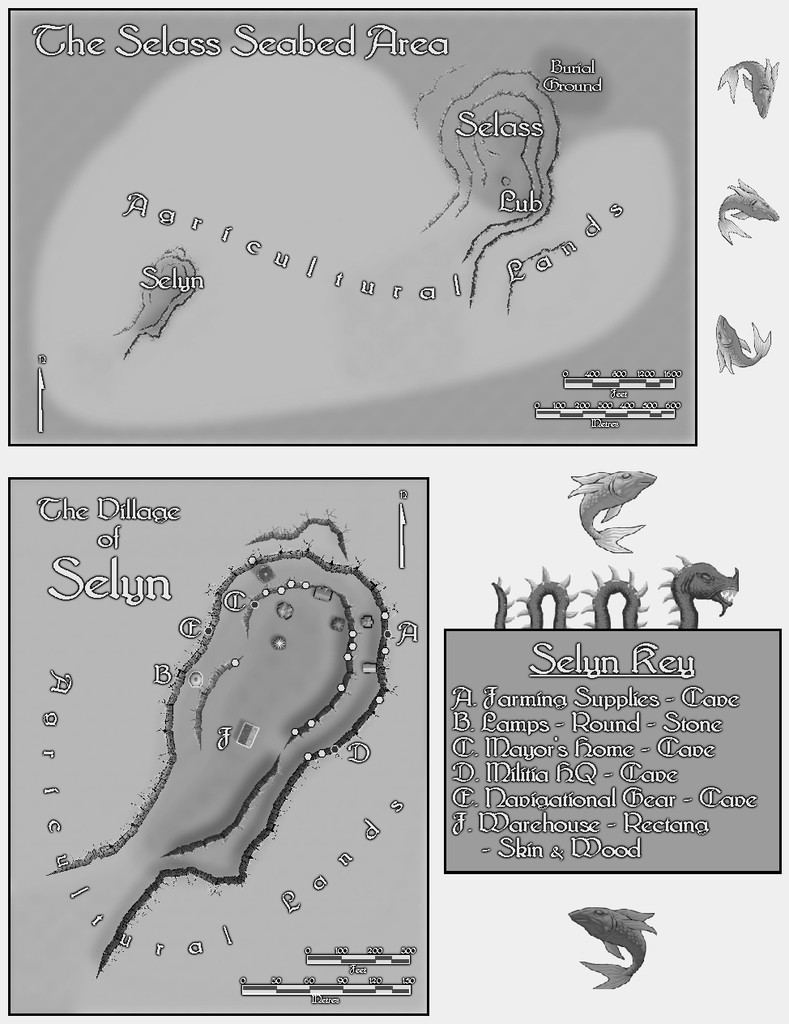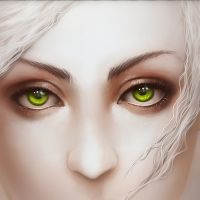
Wyvern
Wyvern
About
- Username
- Wyvern
- Joined
- Visits
- 3,125
- Last Active
- Roles
- Member
- Points
- 5,360
- Rank
- Cartographer
- Badges
- 24
-
Community Atlas: Embra - Enclosed Places
The final Enclosed Places map condenses the remaining five Places, all streets, into a single drawing:
Lots to see here, so let's try a closer view of just the streets:
All the streets had to be designed in a rather different way to the other Places of course, as there were no Judges Guild products that provided plans for such things in isolation. As I noted previously, instead I reworked a set of tables for randomly generating caves and mines from another old Judges Guild text to decide on their lengths, widths, types and layouts, although that system ultimately was more "me" than "JG". Once the base layouts were designed and drawn into the CC3+ map, the streets were redrawn as proper CC3+ streets of the appropriate width and character, and then the CD3 random street options were used to populate them with a range of houses suitable for their overall names and natures.
The streets I came up with were often quite curvy, and the CD3 random street tool isn't too keen on curves and turns, and it can't really cope with junctions at all, so some of the random properties had to be moved, or removed, or adjusted, and sometimes redrawn using a combination of the base shapes that had been generated. Occasionally, some were swapped out for symbols, particularly where I wanted specific or important structures to be. I also decided early on that it wasn't going to be practical to provide interior drawings for all the properties involved - there were simply too many, and that ran the further risk of making them too much alike without a lot of care. I did contemplate doing interiors for selected properties, only to finally decide against that too. So if you need interiors, you'll have to come up with your own for these!
I'll not go into detail here as to what some of the items on these mapped streets are. The PDF and text files in the Atlas should help in that respect. However, it is worth drawing attention to the most significant structure, the Thistle Street Barracks, home to the Knights of the Thistle, Embra's military and police-force, in as much as any Faerie settlement needs such things. These Knights are not entirely my own invention either, as real-world Scottish knights of the realm are known as "Knights of the Thistle" too, though Embra's are naturally of a more magically Faerie kind.
As with all the other individual Places, the idea is these streets can be linked as loosely and in whatever ways GMs may desire to create fresh interpretations of Embra city.
And this is only the first collection of Places in Embra. There are six more such sets still to come!
-
Community Atlas: Embra - Watery Places
Next is another curiously isolated hamlet, this time closer to the River Clack, so it appears on the map as well, although the hamlet's existence is presumably due to the fortuitously-discovered, naturally enough magical, Crimson Rose Well:
As might be guessed, the odd appearance of the settlement and its riverine landing-stages resulted from the original random base map being one showing a small castle and a defended landing on a river. This being Faerie, the defensive walls become high "walls" of thorny vegetation sporting great, heavily scented, crimson rose blooms, and the castle becomes a hamlet-sized community dedicated to looking after the Well and those who come here seeking its magical aid. The fact there could be a powerfully magical sword hidden away within the thorns somewhere (from the featured text) merely adds an extra note of interest. Plus GMs can have fun accounting for why this bit of Embra is so apparently isolated from the rest of the city it needs a substantial landing area all its own on the Clack!
Buildings on the non-streets maps means interiors, and again these are all of just the one storey:
Some of you may recall Eblenn Hill has featured before among these Embra Places maps, as it's the substantial hill the first of the Enclosed Places was set upon, the Freed Haven Floral Garden. Whether the version here is the same or not, and how - or if - it may relate to the "other", is left for GMs to decide.
-
Community Atlas: Embra - Villages
Embra - Winterset in the southwest moves things towards a somewhat different nature, with many clustered properties, and no River Clack. Water comes instead from a pair of well-fountain pools at two midline crossroads, while the not-quite enclosed areas of Aine's Pastures are connected by a bridge that arches over the northern trail, a particularly obscure - thus clearly Faerie - feature:
The interior views show what the layout of the properties really is, although there are many fewer two-storey buildings, as the lower image here demonstrates:
-
Community Atlas: Embra - Villages
The western village of Embra - Evenside carries things to an even stranger place, now with a "castle", Caer Sidi, that is really just an elaborate stone fence around an open field! The Clack here isn't a stream, but a series of ponds linked by marshes that have a couple of bridges over the swampier spots. There's also a huge orchard, and a second dry valley with a scatter of marshy ponds along it too:
This is one map which I think especially benefits from a means to help identify which mapped items are genuine buildings:
-
Community Atlas: Errynor Map 40 - Clack Valley
When I started preparing the Faerie Land map for the Atlas, I already knew I was going to add to it a couple of places which would require further mapping. As it turned out, both would be placed relatively near one another in northwestern Faerie Land, in the River Clack valley.
To better locate both though, it was clear a map covering a much smaller area than Map 40 would be helpful first, which is where the Clack Valley map originated. Examining what the valley looked like on the Faerie Land map, it seemed reasonable to cover the entire length of the River. From that, an area some 50 miles long by 15 miles wide (80 by 25 kilometres) would work nicely, as shown here by the orange rectangle:
Making a hand-drawn copy of this area onto squared paper, much as I often do (see the Map 40 construction topic elsewhere on the Forum for the concept), I then drew-up some new and amended random feature tables to add fresh detail, deciding and setting the results into one-mile squares across the whole valley. From those, smaller rivers could be added in places, also drawing on the general tenor of how and where the various hill ranges had been plotted on the larger map previously. Here too, I'd decided to add a variety of random plants as well as creatures, since real-world faerie lore frequently draws attention to such things as having significance. This all helped give further character to the region.
By this stage, there was an increasing need for a host of new names to highlight some of these fresh significant places. Aside from the randomly-generated names left over from the Faerie Land map, which hadn't been used there, I'd also come across a substantial series of random-name tables on The Collaborative Gamer blog a while before, so I used those to roll-up an extra set of names to choose from, to add to what I had already. Some of the name-options on that blog are heavily Tolkien-based, which I decided against employing here, but many of the other tables read almost like a series of thesaurus entries, giving ideas even when they weren't always used in the strictly random form in which they'd been rolled. Then it came down to fitting the names to suitable specific places. After which, the CC3+ mapping could begin!
Looking through the various mapping styles of those I'd not used previously which work particularly well for handling smaller overland areas, led me to the Alyssa Faden Overland style from the 2014 November Cartographer's Annual. This is supplied with the Bridgnorth font, and that too seemed to fit with what I intended for this area.
This then is the basic map:
There are two small Keys to accompany it, which can be hidden separately if required, one of which brings in the extra labels and markers for the various creatures and plants added to the map:
Although most of the area illustrated falls within the Faerie Land Core zone, as defined already on Map 40, a small part towards the map's left-hand edge is beyond it, as this overlay view shows, also intended to be toggleable in the final Atlas FCW version:
Part of my reason in picking this mapping style was because it comes with its own selection of cloud symbols, so I had to add some of those too:
As these are purely decorative, despite being placed so as not to conceal too much of any important labelled sites, they were set-up so they can be toggled on or off separately as well.
Naturally, the Forum's layout options make horizontally-linear maps particularly difficult to see much detail on, so the images below show the western and eastern halves of the map a little closer:
This last image is larger than the usual Forum preferred size, but it is at least complete!
The Atlas map will also be provided with the usual PDF and text file document of notes explaining more about the map's contents, and which two late medieval Herbals were drawn on especially to add a sprinkle of magic to some of those special plants!
-
Community Atlas: Errynor - Aunty MacKassa's Home & Vehicles
And so to the vehicles. The first of these, the wrecked ship, proved by far the most time-consuming in this Aunty MacKassa set. I'd selected the Sailing Ships pack from the 2009 Cartographer's Annual, which as noted previously, provides only limited help for drawing pre-gunpowder-period vessels, especially as I prepared these illustrations some time before the Annual was updated in April 2021.
My design for what became "The Naughty Lass" (it can sail beneath the waves and on the surface, after all!) was decided following heavy influence from Pauline Baynes' drawings of "The Dawn Treader" in C. S. Lewis' novel of its voyage, along with the nicely-detailed "Sea Ghost" ship drawings in the D&D scenario book "Ghosts of Saltmarsh" (2019, p. 53). This led ultimately to this deck plans map:
I got into rather a mess with this, however, as my initial idea had been to have one vertically-narrow rectangular plan view with the individual decks being toggled on and off one at a time within that condensed space using the map's Layers. Unfortunately, this ran into problems due to interference between the Sheet Effects in the lengthening stack of Sheets per deck, and between decks. So the deck plans had to be separated out, and the map greatly expanded, into the form now shown here. The Layers though ended up partly in the very condensed form as originally envisaged, partly in a more standard format for the decks I'd constructed later in the process. The Sailing Ships pack was meant to show just one deck per map, but that had seemed a little too clumsy for what will be really just a minor adjunct to another map once entered into the Community Atlas. I'd definitely draw the map differently as far as the Layers are concerned, if starting again now. At least it looks more or less OK still, I hope!
From the beginning, I'd also wanted to do a vertical section for The Naughty Lass, as that option is part of the Sailing Ships set-up. So I did, complete with "ghost ship" glow:
And an optional metric scalebar, via an Atlas toggle in the FCW file:
I also had to tone-down the original daytime-bright sky backdrop, to something more dismally matching Aunty's nature.
Again, a PDF and text-file set of notes will accompany both these drawings, in which you can find out about the nature of the ship's "adults-only" figurehead and how it relates - in Aunty's idea of dark humour, naturally - to the vessel's name...
For the Atlas, the Section Drawing is linked from the Coral Cave map via the "ghost ship" symbol in the top right corner, with the Deck Plans map connected from the Section Drawing only.
-
Community Atlas: Errynor - Selass Town
While working on the Ellenge Town map for the Kachaya, I'd also prepared some random tables for designating shops and facilities suitable for Merfolk settlements, given that all undersea civilisations will have a degree of similar requirements for places to live. As I wanted to provide some ideas to the Community Atlas more generally too on developing undersea settlements for all the main races I'd situated in Errynor's oceans, from what had been decided for the Map 01 area, the logical next map was a Merfolk settlement. Of the two still-inhabited ones on Map 01, the Shaldun castle stronghold set in the line of The Cliff itself seemed too similar a location to what I'd already explored for the Shark Bridge area, so I opted instead for the town of Selass out in The Deeps:
I'd already established that Selass was going to be a kind-of independent frontier town, towards the edge of the abyssal plain of Nibirum's greatest ocean, and that the abyssal plain itself would be an area likely to attract adventurers and prospectors. Selass would then have grown to serve their needs in this area. Not wanting to simply drop the settlement onto the routine, flattish, deep ocean floor (the sea's about 3,600 m, nearly 12,000 ft, deep here), and having already worked with some undersea uplands (the Aak Hills), I thought a hollow would be more interesting here. This had the added advantage I could try out @Loopysue's City Cliffs set from the 2020 Cartographer's Annual (CA 165).
Using my random tables, I worked out the size of Selass, and rolled-up what its main features were going to be. The population involved needed two modest villages of agricultural workers and hunters to support it, and them, and dicing for their locations placed one very near Selass, like a "suburb" perhaps, the other a couple of kilometres/a mile or so to the southwest. This meant Selass took on a somewhat elongated look overall, and doodling shapes around this layout brought me to the realisation both Selass + "suburb", and its neighbouring village, could be set into rounded areas where the sea-bed had partly collapsed - when a small magma tube had fallen-in, say, or an especially gassy magma emplacement had led to the sea-floor fracturing in a similar way - places that could have plenty of cliff-opening caves afterwards, suitable for occupation and expansion. Two such places relatively near one another would thus have been ideal for the Merfolk's uses, and included an explanation for why one village had ended up so close to the town, yet could be thought of still as loosely separate from it.
One minor drawback was that the City Cliffs set is intended to work best with the CD3 Bitmap A symbol sets, which are not black-and-white, the overall colour scheme I'd been trying to use for all my undersea settlement maps, due to deciding that while the deep-sea humanoids can all see normally despite the eternal darkness of the deep oceans, their vision without a light source is purely monochromatic. That though was easily overcome by simply applying an RGB Matrix Process Effect set to "Gray" to the entire map. I did have to keep turning it on and off along the way to ensure whatever was being added in colour still worked in greyscale, of course.
Merfolk architecture as I'd envisioned it is pretty eclectic on the whole, so aside from cave-dwellings, a mixture of sea-floor-surface building styles - even some that look remarkably like their land counterparts - would be perfectly reasonable. What seems to be a chimney might be really a vent of some kind, though it could be equally a rooftop accessway, for example. So I drew on all the CD3 Bitmap A symbol sets available, including @ScottA's Celtic houses and @Loopysue's City Domes, to provide an appropriate mix. The switch to greyscale became helpful in another respect, because I needed three shipwrecks, reused as buildings, and the Bitmap A symbols have no ships at all. Luckily the original CD3 vector symbols do have some - not perfect for use as wrecks, but clearly boat-shaped - a difference the use of greyscale helped conceal!
The settlement outlines were to be traced from my hand sketch, once scanned and imported into the CC3+ template, and rescaled to fit the proper area. Using this, I constructed the cliff-lines for both Selass + suburb, and the separate mile-distant village. This took a few tries to get right, as I'd not realised individual segments of the connecting-symbol cliffs couldn't be swapped-out for replacements. After that though, it was easy enough to complete the cliffs.
In order to have the buildings and caves placed randomly - no streets needed on the deep sea-floor, after all - I'd always intended to use the Symbols In Area command to set-up these layouts. So I added basic coloured circles for the relevant Areas within the outer cliff-lines, and populated them with the correct numbers of identifiable symbols of different types for the different surface building shapes chosen, using just the standard Geometry.FSC set from CC3+ at this stage. Once the random patterns were established, it became possible to identify what should go where from the selected properties and places lists randomly determined earlier. The Cave Entrance symbols were moved in places to their nearer cliff-lines, and a few other minor adjustments made, before replacing those except the cave symbols with their final CD3 Bitmap A ones. The most significant change made during this process was to add a cliff stack feature around the southern border of Selass near where it met with that of the adjoining village area, where a particular cluster of symbols had chanced to lie.
Labels and keys were added, along with other surface features in and around the settlements to give them a little more "life", after which an area map was constructed to show the relative locations of the settlements to one another on the sea-bed. For this latter drawing, the cliff-lines from the town and village maps were simply copied and rescaled accordingly. The provided distance scale symbols proved a little too small and unclear when added to the maps, aside from the need to relabel those for the area map, so after adjusting and adding some suitably sized Grid options, fresh scales were produced for these by hand instead.
Hence the final combined map looks like this:
This isn't very clear at the usual Forum resolution, so this is a closer view of just the left half:
And this is the right half:
As usual, a detailed set of text-file and PDF notes was drafted to accompany and explain more about the whole mapped set-up here.
-
Developing a map loosely based on Bronze-Age Mesopotamia
As you'll likely be aware already @aulyre, there's a vast and still-growing literature on the archaeo-historical aspects of the region, and you could easily spend years simply wading through as much of that as you'd care to - I have, certainly, starting back in the 1990s!
Of my own maps of this region, I posted a selection just over a year ago on the Forum here. Unfortunately, this was shortly before the Forum underwent a major revamp to its current incarnation, so the post now looks rather a mess, as we had to embed images rather differently then, using an "[Image_12345]" coding notation, but the images are all still there, just no longer where they were meant to be in relation to the text, so you have to hop up and down to get the full gist properly.
As for references, a couple of atlases I found extremely helpful when I was starting out might be of interest, if you haven't come across them yourself as yet, and a couple of texts.
- Michael Roaf's Cultural Atlas of Mesopotamia and the Ancient Near East (published in 1990), which I was thrilled to discover on checking this evening is NOW FREELY AVAILABLE TO DOWNLOAD COMPLETE (!!!), and with a string of appended corrections, thanks to the kind offices of its author, via the Academia website, as of 2017! Link. I think you will need a (free to join) Academia membership to download the full PDF, but that isn't too onerous. For all its date, it is an astonishingly inspirational work in my opinion.
- The Barrington Atlas of the Greek and Roman World edited by Richard Talbert (2000), which unfortunately isn't available online yet, though it is available for iPad as a download (as of 2013). Otherwise, the hardback version is available to purchase alternatively, which I think still comes with an additional CD-ROM, according to some comments I found online (the library copy I borrowed more than a decade ago had one), including this Wikipedia page, although some of the links from that are now broken. GBP prices (brace yourself!) for the hardback start at about 265 GBP (Amazon UK lists), but the iPad version is a less fearsome circa 15 GBP instead (albeit you'll also need an iPad, so swings and roundabouts...). The Princeton University Press pages for these are here: hardback version -- iPad version. The related Ancient World Mapping Centre website is probably worth a visit as well, albeit they've been having major site issues this year, so a number of links don't work currently. Most of their Free Map pages are still functioning, however, and are certainly worth a look too. The Atlas is another astonishing work, if for a somewhat later period than Roaf's text.
- Civilizations of the Ancient Near East edited by Jack Sasson (1995) is a monumental four-volume collection of specialist essays on all manner of topics for the region. The length and quality of individual contributions can be variable at times, but it is a wonderful means to find out at least some basics on a vast array of topics, with follow-up references to help get you started looking for more. Irritatingly, I can't even find an online description or a complete review of it, though I suspect barring extreme good fortune, it will mean accessing a library copy now anyway.
- Ancient Iraq by Georges Roux (1993) is probably THE classic single-volume introductory text to the region and period. It is, incredibly, and despite its date, still currently in print! You can also find it available to borrow or purchase via the Internet Archive here (limited preview version otherwise).
This has taken a lot longer than I'd expected to compile today, so I won't try to say more; there's enough to be going on with already, I suspect in this little lot!
-
Community Atlas competition entry: The Summer Palace of the Winter Queen
On a roll, so Palace 7 was also done with a black-and-white style package, this time the Inked Dungeons one from CA160 last April, the first time I've used this. I must admit I wasn't too sure about it at first, as it uses a quite "busy" looking fill to mask the outside of the subterranean walls. However, when I selected the various snowflake images for the Palace designs, this flake was probably the most obvious to pick, because it looked so different to many of the others, as elongated on one axis. That in turn set me thinking about larger ice crystals, as the central Crystal Garden area here was a single huge ice crystal on the original image, so far as I could tell. So now this Palace has unusually large ice crystals visible along and buried in its translucent outer walls as well, simply because the style pack set me thinking while I was drawing the map!
In addition, Inked Dungeons comes with relatively few symbols, which isn't so much of a problem with these large-area Palace drawings, since as I've noted above, there can be problems where the symbols have too much interesting surface detail from other style packs. So I used only one, actually designated as a brazier, but repurposed here as its opposite - the fountain in the Crystal Garden - and just drew the few other more obvious features, as has been the case for many of the other Palaces.
The final step once more was to offer the option of a simple blue cover to colour the whole map, as previously, intended to be a toggle option in the Atlas version, and as with Palace 6, added using a blue rectangle with a strong Transparency Effect. Because it stops me panicking when I open the file and find it's just a blank white emptiness otherwise (see the Palace 5 notes above!).
-
Community Atlas competition entry: The Summer Palace of the Winter Queen
Thanks folks!
@Fersus - Yes, I wondered about a hexagonal grid. However, over the past year, I've been involved in discussions about the use of movement grids in RPGs more generally elsewhere, and the consensus has been almost exclusively for square grids (or occasionally none at all). They're such a feature of most published dungeon maps, it's hard to break away from that, I suspect. Plus because hexes don't scale equally in all dimensions, a square grid works better for estimating distances for the GM by-eye.
Given the whole point about participating in the Atlas, and contests like this too, is to try different things, at least from time to time, my intention was to try to make each of the ten Palace maps different. So for the second one, I picked the Old School Blue style from CA12 (also known as the Create Your Own Style pack). Blue, ice, seemed apt!
For continuity, I've decided to stick with the Mason Serif Bold font that comes with CC3+, however.




